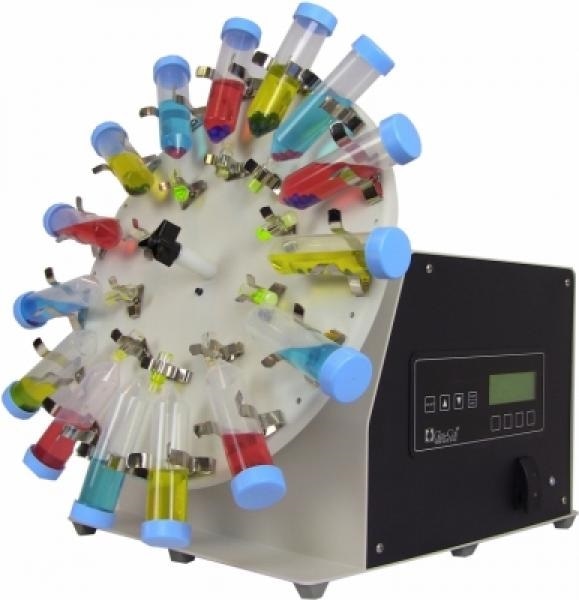Sponsored Content by Glas-ColNov 23 2018
Generally, a mixing system which is capable of continually agitating a mixture in a vessel or test tube at sustained speeds is used to cultivate homogenous liquid solutions. Depending on the mixture’s homogeneity and the geometries of any dispersed particles in the solvent media, a rapid centrifugal force or a gentle sloshing motion may be required.

Magnetic stirring is included in conventional laboratory mixing systems. This encourages dissimilar liquids or solid particles to disperse in a solvent via radial flow. Although this is a relatively fast method, it is limited to experiments on a small-scale as only small containers can be accommodated by the magnetic stirring apparatus. Consequently, lower liquid volumes can be accommodated than in other techniques.
Direct-contact drive shafts are used by alternative homogenizers in order to improve the homogeneity of dispersions. However, experienced personnel are required to operate these whenever the mixing system is being used.
Rotating mixing systems, known as ‘centrifugal mixers,’ are designed in order to improve the autonomy of laboratory mixing systems as well as to enhance the throughput of homogenous mixing experiments. The benefits of using a Glas-Col rotating mixing system are explored in further detail in this article.
Digital Pulse Mixing System from Glas-Col
Glas-Col’s digital rotator is equipped with state-of-the-art brushless control technology. This provides analysts with a unique solution to a number of common laboratory issues. This mixing system’s defining feature is its rotating disc, which can be augmented with a variety of different housings for vials and test tubes of varying sizes.
Tubes with a diameter of between 10 and 30 mm can be facilitated via the attachment of small or large clips, with the option to house vials with a variety of different geometries simultaneously and enable simultaneous mixing of solutions with widely ranging homogeneities.
Throughout the entire automated or timed event, each test tube is easily visible. This enables analysts to observe process conditions visually without interrupting the experiment.
It is easy to attach the rotating aluminum disc to the drive bar, which is powered by a continuous-duty, robust motor. This motor can generate speeds from 5 to 83 rpm. Speeds at the lower end of the spectrum are characterized as gentle sloshing, while higher speeds are referred to as rapid agitation. The mixing system can operate for demanding operation periods across this full range of motion.
Rotational speeds can be determined by analysts to within 1 rpm, courtesy of the simple membrane switch user interface. This also allows users to define the mixing system’s timing parameters in advance.
The instrument is perfect for the homogenous mixing of well-characterized solutions and materials, enabling facilities to sustain the distinct mixing conditions which are required in order to prevent the agglomeration or precipitation of common solutions.
In order to enable real-time data acquisition of experiment conditions and allow remote computer control, it is possible to install additional Labnetix® software to support the homogenous mixing and experimental re-suspension of solutions with outstanding degrees of automation.
Mixing Systems from Glas-Col
A robust range of laboratory instruments is provided by Glas-Col for facilities across the globe. Their background in the manufacture of robust heating mantles has enabled them to explore the wider possibilities of precision technologies and labware. This has led to the manufacture of a leading-range of data acquisition instruments, heaters, mixing systems, and more.
About Glas-Col
Glas-Col is the world's leading manufacturer of laboratory products and industrial heating and mixing technology. The combination of modern facilities, and highly trained personnel, keep Glas-Col on the leading edge of technology for pharmaceutical, biotechnology, semiconductor, industrial, and the research & development industry.
Ongoing product development, using state-of-the-art manufacturing concepts and materials, is one of the key ingredients to Glas-Col's continued success in meeting our client's application requirements.
With over 70 years of experience Glas-Col is also capable of meeting the needs of researchers and scientists. Our laboratory equipment and industrial products are backed by our excellent service, support and technical know how. Glas-Col is an ISO certified company and has maintained this certification for fourteen straight years. Our goal is to provide quality laboratory equipment, safety accessories and industrial products which will provide you, the customer, repeatable, reliable, results.
Sponsored Content Policy: News-Medical.net publishes articles and related content that may be derived from sources where we have existing commercial relationships, provided such content adds value to the core editorial ethos of News-Medical.Net which is to educate and inform site visitors interested in medical research, science, medical devices and treatments.